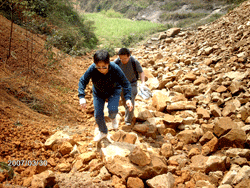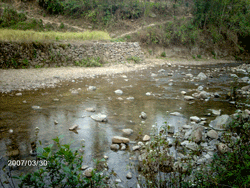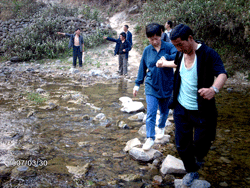VISIT TO SAN HE VILLAGE
Anna describes her first visit to investigate the request for a bridge at San He.
The Journey

On 30 March 2007, Jamie from NCL and I left at 10.30 a.m. in the NCL vehicle for San He village. After our lunch at Mao Chan, we traveled another half an hour before we arrived at Da Ying. San He was still another 8 km away. We left the car there to continue the rest of the journey on foot. We crossed a small river using stepping-stones. It was hot that day, about 30 degrees Celsius. Under the sweltering heat, we walked the treeless path that snaked its way up and down the mountain. After half an hour, we came across a rocky path. Again we had to climb the path, making our way up and down the mountain, this time through the trees until we reach the top. We had been climbing for more than an hour and I was totally worn out and breathless by this time. From the top of the mountain, the people pointed out to us that the bridge was somewhere near the school. They had no intention of taking us all the way to see it. I realized then what our liaison officer Mr. Lu meant when he told me that we had to walk for an hour. I insisted that they take me to see the bridge as I had to take some pictures of the place for the report to RBCS. They tried to dissuade me by telling me that it would take another hour to get there.
The background to the request
Nevertheless, we continued on our journey and arrived at the house of the village head, Mr Xie Xing Rong. We made some inquiries there and found out that as there was no good road to the nearest town, the villagers had to carry their goods and produce up and down the mountain on foot to the nearest town to sell their goods. Some are lucky to have horses. The selling price of their produce is low compared to other places. According to them, chicken only cost RMB 8 per kg in their village while in Ziyun it would be sold at RMB 24 per kg. Because of the economical benefit of having a proper road, the villagers decided to contribute towards making a good road. The total cost of the road project was estimated to be RMB 200 000. They could only manage half the amount, around RMB 100 000. Some of the farmers had to sell their cows to contribute towards the road which is now under construction. They have made an appeal to the local Government for assistance. Because of that, they could not possibly request the Government again for the construction of the bridge. So they have turned to RBCS for financial help to build the bridge.
Dog meat!
Mr. Xie’s family and the villagers treated us to a grand dinner. They slaughtered a dog and a chicken. Dog meat is considered to be special, especially for important guests. As Jamie and I do not eat dog meat, we declined the dog dish and settled for the chicken instead. Fortunately, there was chicken or else they would have been insulted if we hadn’t eaten the meal.
The bridge(s) over troubled water

After the meal, we set off to see the bridge. The village students have to cross two rivers to go to their school. The County chief made a submission on behalf of the villagers earlier for a bridge to span across one of these rivers which is 6 m wide. The original bridge had been destroyed by flood waters. There is still a bridge across one of these two rivers. During heavy rainfall, the river would swell to flood the bridge. The schools kids are too frightened to cross using the bridge when it is raining and when the water level allows it, the teachers would wade across, carrying the children to school one by one from one side to the other. During the rainy season, the water level would reach 7 to 8 feet high. The students are then forced to stop studying from ten to fourteen days.
If the villagers were to go ahead with the first plan, they would still have to request for another bridge to replace the old existing one which is unusable during the rainy season. After some considerations, they decided on a single bridge with a span of 15m to be built further downstream from the school. This bridge will then solve the problem of accessibility for the students as well for the whole village.
More walking!



